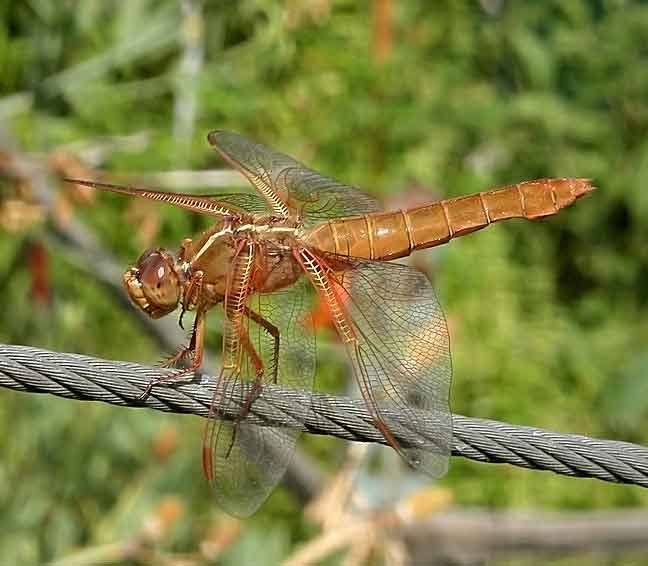
Libellula saturata , female (*)
Superregnum: Eukaryota
Cladus: Unikonta
Cladus: Opisthokonta
Cladus: Holozoa
Regnum: Animalia
Subregnum: Eumetazoa
Cladus: Bilateria
Cladus: Nephrozoa
Cladus: Protostomia
Cladus: Ecdysozoa
Cladus: Panarthropoda
Phylum: Arthropoda
Subphylum: Hexapoda
Classis: Insecta
Cladus: Dicondylia
Subclassis: Pterygota
Cladus: Metapterygota
Cladus: Odonatoptera
Cladus: Holodonata
Ordo: Odonata
Subordo: Epiprocta
Infraordo: Anisoptera
Superfamilia: Libelluloidea
Familia: Libellulidae
Subfamilia: Libellulinae
Genus: Libellula
Species: Libellula saturata
Name
Libellula saturata
Vernacular names
magyar: Mexikói laposhasú acsa
The flame skimmer or firecracker skimmer (Libellula saturata) is a common dragonfly of the family Libellulidae, native to western North America.
Description
Male flame skimmers are known for their entirely red or dark orange body, this includes eyes, legs, and even wing veins. Females are usually a medium or darker brown with some thin, yellow markings. This particular type of skimmer varies in size but is generally measured somewhere between two and three inches long.[2] These naiads are known for being rather large and chubby-looking due to their rounded abdomen. They are covered with hair but, unlike most young dragonflies, they lack hooks or spines.
side view
side view female
Location
Due to its choice habitat of warm ponds, streams, or hot springs, flame skimmers are found mainly in the southwestern part of the United States. They also make their homes in public gardens or backyards.
Feeding habits
Nymph of Libellula saturata from California.[3]
An immature flame skimmer (nymph) feeds mainly on aquatic insects. Its diet consists of mosquito larvae, aquatic fly larvae, mayfly larvae, freshwater shrimp, small fish, and tadpoles. The nymphs, which live in the mud at the bottom of warm streams or ponds, catch their prey by waiting patiently for it to pass by. Adult skimmers usually feed on moths, flies, ants, or any other soft-bodied insect while waiting perched on a small rock or twig or while flying through the air.[4]
Reproduction
Breeding for flame skimmers occurs during their flight season from May to September. Males compete with other males for prime breeding locations and females.[5] After mating, the male and female separate, and the female flies off alone to lay her eggs. She does this by hovering above small streams or ponds and dipping the end of her abdomen into the water. Often she deposits her eggs in many different places in order to prevent the naiads from using each other as a source of food.
Male flame skimmer
References
Uhler, Philip R. (1857). "Contributions to the Neuropterology of the United States. No. 1". Proceedings of the Academy of Natural Sciences of Philadelphia. 9: 88. JSTOR 4059192.
Kris Wetherbee, Kris. Attracting Birds, Butterflies & Other Winged Wonders To Your Backyard. New York, New York: Sterling Publishing Company, Inc., 2005.
Needham, James G. (1904). "New Dragonfly Nymphs in the United States National Museum". Proceedings of the United States National Museum. 27 (1371): 705–706. doi:10.5479/si.00963801.27-1371.685; Pl. 42, Fig. 1. {{cite journal}}: External link in |postscript= (help)
Lung, Mark, and Stefan Sommer. "Libellula saturata." Idaho Museum of Natural History., 1 2001. February 27, 2008
Mason, Jim. "Dragonflies & Damselflies." Great Plains Nature Center. Archived 2008-02-21 at the Wayback Machine, March 13, 2008
"Libellula saturata". Integrated Taxonomic Information System. Retrieved 8 February 2006.
Mason, Jim. "Dragonflies & Damselflies." Plains Nature Center, March 13, 2008
Sabet-Peyman, Jason. "Introduction to the Odonata." University of California Museum of Paleontology. University of California, Berkeley., March 13, 2008
Retrieved from "http://en.wikipedia.org/"
All text is available under the terms of the GNU Free Documentation License

